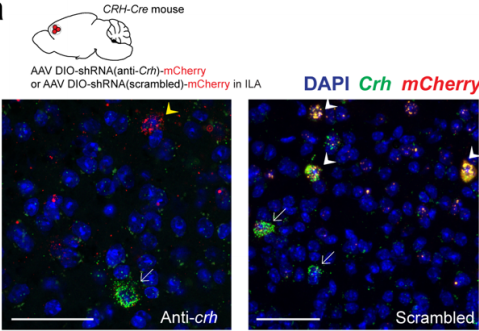Custom-Made AAVs were used for the regulation of gene CRH expression. (From
BrainVTA)
The viruses used in this article from BrainVTA are in the table below
|
Custom-Made AAVs |
PT-2784 rAAV-U6-shRNA1(CRH)-CMV-EGFP-SV40-polyA
PT-2785 rAAV-U6-shRNA2(CRH)-CMV-EGFP-SV40-polyA
PT-2786 rAAV-U6-shRNA3(CRH)-CMV-EGFP-SV40-polyA
PT-0916 rAAV-U6-shRNA(scramble)-CMV-EGFP-SV40-polyA
PT-2827 rAAV-CMV-CRH-P2A-EGFP-WPRE-hGH-polyA
PT-2787 AAV2/9 CMV-DIO-(mCherry-U6)-shRNA(anti-Crh)
PT-2788 AAV2/9 CMV-DIO-(mCherry-U6)-shRNA(scrambled) |
Noelia Sofia de León Reyes, Paula Sierra Díaz1, Ramon Nogueira, Antonia Ruiz-Pino, Yuki Nomura, Christopher de Solis, Jay Schulkin, Arun Asok and Félix Leroy
Pub Date: 2022-03-16,
DOI: 10.1101/2022.03.15.484224,
Email: sales@brainvta.com
Social preference, the decision to interact with one member of the same species over another, is a key feature of optimizing social interactions. In rodents, social preference relies on both extrinsic factors, such as sex, strain and kinship, and intrinsic ones, such as the memory of previous encounters, which favors interactions with novel compared to familiar animals (social novelty preference). At present, it is unclear which neuronal circuits guide social preferences and whether such circuits promote social interactions with the preferred individuals or suppress interactions with the non-preferred ones. Although both the infra-limbic area of the pre-frontal cortex (ILA) and the lateral septum (LS) have been shown to support social novelty preference, the neuronal circuits and molecular mechanisms by which these brain regions interact to regulate social interactions are unknown. Here, we identify a population of inhibitory neurons in ILA that express the neuropeptide corticotropin releasing hormone (CRH) and project to the rostro-dorsal region of LS (rdLS). Release of CRH from ILA in rdLS during interactions with familiar mice disinhibits rdLS neurons, thereby suppressing interactions with familiar mice and contributing to social novelty preference. We further demonstrate how the maturation of CRH expression during the first two post-natal weeks enables the developmental shift from a preference for littermates in juveniles to a preference for novel mice in adults.
 Figure 1. CRH-Cre mice injected in ILA with AAV2/9 CMV-DIO-(mCherry-U6)-shRNA(anti-Crh) to downregulate Crh or control AAV2/9 CMV-DIO-(mCherry-U6)-shRNA(scrambled) (top).
Figure 1. CRH-Cre mice injected in ILA with AAV2/9 CMV-DIO-(mCherry-U6)-shRNA(anti-Crh) to downregulate Crh or control AAV2/9 CMV-DIO-(mCherry-U6)-shRNA(scrambled) (top).
In this study, the authors demonstrate the neuronal circuits and molecular mechanisms of social preferences through a combination of electrophysiological, chemogenetic, optogenetic, calcium recording and gene silencing techniques. The authors identify a population of inhibitory neurons in ILA that express the neuropeptide corticotropin releasing hormone (CRH) and project to the rostro-dorsal region of LS (rdLS). Release of CRH from ILA in rdLS during interactions with familiar mice disinhibits rdLS neurons, thereby suppressing interactions with familiar mice and contributing to social novelty preference.
BrainVTA offers viral vector construction & virus packaging services for AAV, LV, RABV, PRV, HSV and VSV that help researchers explore questions about genes, neurons, circuitry structure, function of brain network, mechanism and treatment of diseases.
If you have any needs, just email us at
sales@brainvta.com.
